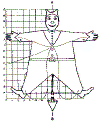By Leslie Hunt

FIG. 16.
THE IMP KITE COMPLETE
The squares are 2 inches square, and are to
be used in drawing the outline as described in the directions.
The construction of the Imp may be understood best from the figures. The same treatment of the sticks, framing strings, and paper as given heretofore should be followed.
The sticks need not be wider than 3/16 of an inch. It is first necessary to form a pattern. Select a sheet of plain paper about 2 by 3 feet and fold a crease the long way through the center. Rule one side lightly in 2-inch squares and copy the Imp outline from Figure 16.
The kite is the same shape right and left, so it will be necessary to draw only one side. Hold the drawn side against a window, and trace the other half of the figure. Unfold the pattern and cut close to the outline.

FIG. 17.
FRAME OF IMP KITE
Except the wire forming the head, notice all the
framing may be easily done with string.
The sticks need not be more than 3/16 inch wide, but they should be reasonably straight and pliant. Lay the sticks on the pattern to conform, but do not vary too much from the suggestions or the balance will be hard to find.
Frame the kite with string; paper as usual with appropriate colors. The head should be framed with wire and the horns supported with slivers glued on.
The introduction and Figure 4 give suggestions for stiffening parts of the kite that are flimsy.
Draw the features boldly. Cut out the eyes, and glue waxed paper over the holes on the back of the kite. Replace the iris and pupils on the waxed paper and you will have a pair of eyes well suited to any Imp. The hands and feet may now be added. These are to be cut from stiff paper, tinted, and reinforced by slivers or trough-shape papers, as shown in Figure 4.
Run a loop from one wrist to the other, and another loop from one ankle to the other. The first loop should be about 24 inches when finished and the other loop about 44 inches.
The towing point will be along the line joining the centers of the wrists about 5 1/2 inches from the kite.
About 15 feet of 1 1/2-inch festoon will be needed for a tail. Tie the tail midway between the feet with a taut string; if this is neglected, the Imp will oscillate in the air and prove a poor flier. Complete the tail with a spearhead made of a cone of thin cardboard covered with red paper. Glue the tail deep in the cone and center it at the top by means of cross strings. The cone should be about 5 inches long and about 4 inches in diameter. Do not make it too heavy.
A kite made by the above directions, rated .61 ounce per square foot. It was an excellent flier.